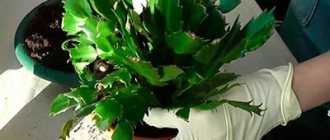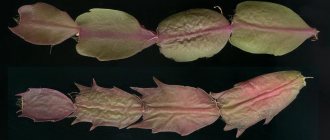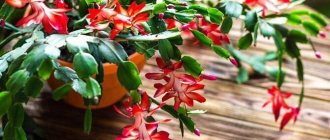In most cases, if you ask a person to describe a cactus, the result will be the same. A plump, gnarled little inhabitant of desert lands, covered with very sharp thorns. Few people go further than this definition. Someone might add that cacti bloom periodically and do not require frequent watering. This is where the baggage of botanical knowledge ends.
Therefore, many will be interested to know that the pretty plant, which we are all accustomed to calling “Decembrist”, is nothing more than a type of cactus. Its appearance can, of course, be misleading. Instead of the usual dense shoots, this flower develops long, jointed shoots. Common cactus spines of Schlumbergera (Schlumbergera)
does not have.
And you can’t call her a drought lover. The plant is also known to many under the names “ Rozhdestvennik
”, “
Decembrist
”, “
December
”, “
Christmas cactus
”.
By the way, this name was given to the flower by the collector A. Cunningham, who brought the plant from the forests of South America - not a very common place for cacti to grow, right?
Landing
Considering the location of the forests in which Schlumbergera traditionally grows, it is necessary to choose a sufficiently bright place for the flower where the sun's rays will be scattered. The pot should not be exposed to the full sun, since under natural conditions the shoots of this cactus cling to tree trunks, multiplying in their shade.
The roots of the plant are very short, so planting is carried out in a small container. For example, a plastic glass or a small pot. For beauty, you can choose a container with the same shade as the future flowers.
Location and lighting
In the apartment, the “Decembrist” will be comfortable on the windowsills of the western and eastern sides of the house. There is enough sun here to grow well and not so much that it dries out. Lighting should not be concentrated on the plant. Direct midday sun will cause irreparable damage. There is also no need to place a flower pot above radiators and heaters if you want to create a tropical climate. The ideal location for Schlumbergera in the warm season is on the veranda.
If the flower will live in the country, it must be protected from snails and slugs. A good solution would be to hang the pots in the shaded part of the garden.
Pot size
In its homeland, “Decembrist” begins to grow not in the soil near the trees, but on the trunks themselves and on the branches. Most likely, this is why the root system of the flower is poorly developed. The plant does not need to obtain nutrients by going deeper into the soil. Therefore, during initial planting, the size of the pot should not be large. 10 cm in height and 6 cm in diameter is enough.
The soil
The growth and development of any plant that is grown artificially depends on the conditions created. When the atmosphere is as close as possible to the natural habitat, flowers grow and bloom beautifully. The same thing happens with the “Decembrist”.
While the plant climbs tree trunks and branches, its roots have direct access to air. From this we can conclude that the soil should be as loose and breathable as possible.
To create such conditions, mixtures of peat, coarse sand and deciduous or turf soil are excellent. Classic mixture: 1 part earth and 1 part sand. Charcoal can serve as a pleasant addition to the standard composition.
But Schlumberger will not tolerate clay and loam - the substance is too dense and moisture-proof, in which access to air is severely limited.
Under the layer of soil in the pot you need to make drainage from crushed brick or small expanded clay. The drainage layer must conduct moisture well, since the Decembrist does not tolerate stagnant water
The acidity of the soil in the pot should be maintained at 5-6 PH.
Schlumbergera is a very unpretentious plant. It can develop in less nutritious soil, but then its flowering will be less pronounced or stop altogether.
Transfer
Before transplanting the plant, you need to prepare a new pot. Its dimensions are selected based on the dimensions of the previous container. The depth of the pot can remain the same. As with all plants of this species, the roots of Schlumbergera grow in the top layer of soil, without sinking too low. Therefore, the root system of the flower must be given the opportunity to grow in breadth and not in depth. It is necessary to select a new pot so that its diameter exceeds the previous one by 2-3 cm.
Transplantation occurs when the flowering period has passed. It is best to choose a day during the growing season. Flower growth occurs over the course of one month from late March to mid-April. If the plant is young, it is replanted annually, older flowers - once every two years.
The plant must be provided with rest after transplantation and good soil drainage. The root system of newly transplanted flowers is especially susceptible to rotting, so do not forget to add drainage litter.
Fertilizers and fertilizing
You need to feed the flower during flowering and growth, that is, no more than 2-3 times a year. Typically, fertilizers contain nitrogen, potassium and phosphorus. The optimal ratio is 9:24:18. You can use complex fertilizers, but you need to be careful to ensure that the nitrogen content is average. You cannot overdo it with this element, since its excess can cause active rotting of the root.
In general, Schlumbergera is considered a very unpretentious plant. For a long time it can grow and develop in very poor soil. But at the same time, the appearance of the plant will be unsightly.
During feeding, the flower should be in a well-lit room. Young shoots, stretching out in search of light, become brittle and faded. If the fertilizers and feeding time were chosen correctly, the “Decembrist” will grow magnificently.
Watering
Considering the climate native to Schlumbergera, the humidity of the soil and surrounding air must be maintained appropriately. In summer and during flowering, the plant is watered abundantly and evenly. The water should be warm and soft. The rest of the time, watering is reduced to a minimum. Once a week will be enough, you need to make sure that the soil does not dry out.
Growing conditions
Decembrist is a branched flower that belongs to the cactus family and forms a large number of inflorescences. Its natural habitat is the tropics. The plant has flat, segmented shoots with jagged edges. A distinctive feature is the absence of thorns . Each shoot consists of several segments, the length of which can reach 5 cm. New segments appear on the tops of old ones, forming long and lacy shoots.
Schlumbergera flowers (this is the official name of the Decembrist) are formed at the top of the shoot, the petals are shaped like tubes. The maximum size of inflorescences can reach 10 cm. The color range of flowers ranges from soft pink to dark red . The structure of the buds depends on the plant variety.
For the flower to fully grow and develop, it is necessary to create the most comfortable conditions for it. Despite belonging to the cactus family, Decembrist is more demanding on the frequency of watering, soil type and lighting. The Christmas flower needs regular watering and protection from direct sunlight. Poor soil quality and overdried soil can provoke the development of diseases and death of the plant.
When choosing a plant location, you should give preference to windows that face north or east and have diffused lighting. Comfortable temperature conditions range from +10 to +20 degrees. The optimal temperature for flowering in winter is +15 degrees. Experienced gardeners advise avoiding sudden temperature changes.
To ensure uniform formation of new segments on all shoots, you must regularly rotate the pot relative to the window glass.
During the period of bud formation, it is strictly forbidden to carry out this manipulation due to the possible shedding of flowers. To increase the flowering period, it is necessary to place small pieces of ice on the surface of the soil. The main conditions for the formation of a large number of buds are low light levels in winter and the absence of an additional source of artificial light.
A high level of humidity is another indicator that affects the condition of the Decembrist. To humidify the air, it is advisable to place containers of water or different types of tropical plants on the windowsill. An indicator of a comfortable humidity level is the presence of aerial roots between the shoot segments. In winter, it is strictly forbidden to place plants near heating devices or create artificial partitions between the radiator and the indoor flower. To form a crown or obtain planting material, it is necessary to pinch off shoots and under no circumstances use cutting objects.
Caring for the Decembrist at home
Caring for the Decembrist is simple, just remember its origin. Imagine a tropical forest: humidity, diffused light, no drafts, constant temperature all year round, nutritious soil and warm rains.
Create conditions close to tropical and your Decembrist will delight the eye with flowering not only in winter, but also in summer. Even if there is no need to force the Decembrist to bloom in warm weather, then for the sake of the health of the plant it is still recommended to create a semblance of the tropics at home.
Humidity can be provided by regular watering and spraying with warm, soft water. There is nothing complicated here: you need to water the Decembrist regularly , not allowing the earthen ball in the pot to dry out, and spray it daily, especially when the heating is on.
Diffused lighting can be created by placing it on an eastern or western window sill, or in the back of the room so that direct sunlight does not fall on the Decembrist stems. The scorching sun burns the leaves, and the plant begins to hurt, there is no time for flowering. Avoid placing a pot with Decembrist on a southern window sill. Decembrist stems turn yellow from sunburn, and the stem segments dry out and fall off.
Do not grow Decembrist in corridors and near windows that open to ventilate the room - drafts are guaranteed to undermine the health of Schlumbergera. Remember, the air around the Decembrist should stagnate.
Decembrist flowers fall off due to drafts and changes in place of residence. Photo: Chris Brenschmidt/Flickr
If there is a need to grow Decembrist on a balcony or loggia, then select a shady place for the plant, protected from the wind.
When the Decembrist forms buds and blooms, it is not recommended to rearrange or rotate the pot - the plant can throw off the buds and leave you without the “sweet”.
If there is a need for Decembrist to bloom repeatedly throughout the year, then after flowering the plant is moved to a cool place to rest. It is the alternation of periods of rest and flowering that guarantees repeated flowering of the Decembrist.
The tropical forest is warm all year round, which means that the comfortable temperature for the Schlumberger zygocactus is from +20°C to +25°C . This is the temperature in the phase of active growth and flowering, and for the dormant period a temperature of about +13-15°C is recommended.
Feed the Decembrist 2 times with complex fertilizer for flowers, making the concentration 2 times less than recommended. Zygocacti are very sensitive to large doses of fertilizers, so you should not overfeed Decembrist, especially during the dormant period.
Rules for pruning yucca
At home, yucca rarely branches on its own. The plant stretches greatly, reaches a height of more than 2 m and loses its decorative effect. Plants whose trunks are at least 6 cm in diameter and 50 cm in height are pruned. Less thin trunks will not withstand the load.
The only time when this can be done relatively without damaging the plant is the beginning of spring. At this time, the plant begins to emerge from the state of forced dormancy, in which it remains from October to February.
A plant pruned after the start of active growth will not cope with simultaneous nutrition of the vegetative mass and healing of wounds. In such cases, yuccas often die.
For pruning you will need:
- sharp garden knife;
- alcohol solution;
- liquid paraffin or garden varnish.
The cutting location is chosen depending on the preferred height. The optimal height is 10-15 cm from the lower leaves. This size works well for standard room heights.
1-2 days before the procedure, the yucca is watered generously. The pruning tool is disinfected with alcohol, and the place for the cut is marked.
The leaves of the plant are clamped into a bunch with the left hand, and a cut is made with the right
It is important to carry out pruning with clear movements, trying to avoid creases and damage to the cambium. After this, the sections are poured with liquid paraffin or treated with garden pitch.
It is not recommended to trim several large trunks at the same time. The plant most likely will not cope with the healing of large wounds. Pruning of such yuccas is carried out over two seasons.
The trimmed plant is placed in a warm and bright place, preventing direct sunlight.
It is important to try to ensure that as much light as possible reaches the lower top of the plant.
In some cases, pruning yucca may be necessary for medicinal purposes. It is carried out when the trunk rots, cutting it down to living tissue. Therapeutic pruning can be carried out at any time.
Since the volume of vegetative mass decreases several times, watering of yucca is significantly reduced. It is recommended to water no earlier than 2 weeks after pruning. Subsequent irrigation is carried out after the earthen clod has completely dried out.
Under favorable conditions, after 7-10 days in young plants and about 20 days in old plants, you can notice the awakening of dormant buds on the trunk near the cut. Subsequently, the yucca is cared for according to the recommended rules.
Decembrist transplanting and pruning
From time to time, the Decembrist plant needs to be pruned and replanted into another pot, so it is worth knowing the features of pruning and replanting the plant. Usually the Decembrist is transplanted once into a pot of larger diameter (2 cm larger).
Decembrist is transplanted immediately after flowering, in February, into a wide, low pot, which provides drainage from pebbles or small crushed stone. There must be holes in the bottom of the pot.
The composition of the soil for Decembrist is as follows: peat, nutrient soil and sand, in a ratio of 2:1:1. In any case, the soil should be loose and nutritious.
Experienced cactus growers add crushed charcoal, vermiculite and coarse river sand to the Decembrist substrate to improve the air and moisture permeability of the soil.
Decembrist is pruned in June to give the plant an attractive appearance. Most often, regular anti-aging pruning is performed: ugly stems and stems growing crookedly are removed. To remove diseased stems, sanitary pruning can be done at any time of the year.
Diseases and pests of the Decembrist
The Decembrist plant is a perennial plant, therefore, during its life, the zygocactus can be attacked by pests and affected by diseases of various types, so the plant must be inspected regularly.
Most often, Decembrist is damaged by mealybugs, spider mites, scale insects and whiteflies. Having discovered pests, it is worth trying folk remedies: washing with soapy water, washing with vodka, etc., and only then using chemicals.
Like tomatoes and peppers, zygocacti are susceptible to late blight, fusarium and other fungal diseases. Most often, the cause of fungal diseases is waterlogging of the earthen clod and poor drainage. Fusarium usually affects the root collar of the Decembrist plant, the plant withers and becomes faded. Treatment of fungal diseases is carried out with fungicides, without waiting for the death of the plant.
Decembrist does not bloom: reasons
Most often, Decembrist does not bloom due to improper growing conditions: little moisture, little light, cramped pot, poor soil, etc.
In any case, in order for the Decembrist to bloom, it is necessary to prepare it for flowering, ensuring peace in the fall, putting it in a cool room. At this time, the Decembrist is not watered or fed.
At the end of November, you need to move the zygocactus to a warm, bright place, start watering and feeding. After dormancy, the Decembrist quickly wakes up and forms buds.
When the Decembrist has formed buds and begins to bloom, it is necessary to provide illumination of the plant with an additional light source.
Rules for home care for a Decembrist
Following the simplest rules for caring for zygocacti will protect your plants from diseases and pests.
- During flowering, provide the zygocactus with good lighting and do not move the pot;
- During flowering, do not cut cuttings for propagation;
- Avoid temperature changes during flowering;
- In a cool room, Decembrist blooms longer;
- A narrow pot promotes abundant flowering;
- After dormancy, water and feed gradually to avoid shock;
- Decembrist flowers fall off due to a sharp change in conditions. There is no need to panic - the Decembrist will get used to the new conditions and bloom again.
Reasons for Decembrist leaves falling
The Decembrist sheds its leaves (stem petioles) when the conditions of detention are close to unbearable. Examine the plant carefully - perhaps pests drink the cell sap of the zygocactus like fleas. If no pests are observed, then the cause of leaf fall lies in a lack of nutrients in the soil or inappropriate growth factors: temperature, humidity, lighting, etc. replanting can also cause petioles to fall off.
Features of care after transplantation
The transplant procedure for a plant at first will be fraught with negative consequences in the form of stress, so it is very important to provide the Decembrist with the most comfortable conditions, and first of all, peace.
Features of caring for zygocactus during this period are as follows:
- It is forbidden to water the Christmas tree for the first 5 days after transplantation. Only regular and abundant spraying with warm water is allowed.;
- Since the Decembrist needs rest, the container with the plant must be moved to a room with a temperature no higher than +13 ° C and at first not brought near a source of heat and light.
- Feeding also needs to be stopped for some time. Like watering, this procedure also returns gradually.
- After the Christmas tree has more or less adapted to its new environment, it is recommended to pinch the shoots to form additional branches, which will further contribute to more intensive creation of buds.
Flower propagation
After giving the plant a rest, you can try to propagate it. This procedure is absolutely not difficult and can be performed in 2 ways: in water or in soil. Having unscrewed the cuttings with several new sections, they need to be placed in water for 2-3 days, monitoring the condition of the water - if it immediately becomes cloudy, replace it with a new one and add an activated carbon tablet.
Find out how to feed indoor plants at home.
When propagating a plant in the ground, dried cuttings should be placed in slightly deepened containers in the center with 2–3 cm of soil. In a warm room, the cuttings are not covered with anything, but if the temperature rises to 20 ° C, they should be covered with a jar and ventilated periodically to avoid the appearance of fungus.
How to propagate Decembrist
The easiest way to propagate Decembrist is by propagation by green cuttings. Cuttings of zygocacti allow you to get a flowering plant for the next year. Zygocacti are propagated by seeds only by breeders.
Cuttings are taken from the tops of healthy stems. It is enough to cut off two leaves (green segments of the stem).
Green cuttings should be withered for two to three days and planted in containers filled with nutrient soil. You can root Decembrist cuttings in ordinary seedling boxes, under a lid.
Why is a flower pruned?
- After pruning old shoots, the Decembrist begins to bloom more profusely. The formation of buds occurs exclusively on new young shoots. They are stronger and capable of producing a large number of flowers.
- Pruning is also carried out to form a beautiful and even bush. Because over time, the flower stems begin to branch and the plant becomes shaggy. But giving the plant the shape you like depends on your imagination and taste.
- Also, pruning will allow the plant to live longer. Some varieties of Decembrist bloom for more than twenty years. But such a long plant life requires good proper care and timely plucking.
As Schlumbergera grows, the lower branches will grow in length and droop. If you do not want to “prune” it, it is recommended to hang the plant on a flowerpot. This way the long branches will hang down and feel comfortable.
What is it for?
Replanting is an essential element in the care of any plant, thanks to which the active growth of the bush and its abundant flowering are stimulated.
Decembrist transplant is required in 3 cases:
- The first transplant of a plant is carried out immediately after purchasing it at a flower shop.
Planned transplant. A young plant needs to be replanted annually, an adult - once every 3 years. If the Decembrist has reached too large a size, then it must be replanted once every 5 years.
The main purpose of this type of transplant is to change the soil or select a larger pot.
- If the plant is affected by diseases and pests. To eliminate some of them, urgent replacement of the soil is required.
Soil for the Decembrist: how to prepare the soil yourself and what substrate to choose in the store?
On cold winter days, blooming Decembrists delight their owners with the bright lights of flowers. This is probably why zygocactus (Decembrist, Rozhdestvennik, Schlumbergera) is one of the most popular plants among gardeners, and also because of its ease of care.
However, few people know that Schlumbergera is quite demanding on the composition of the soil in which it grows. If a gardener approaches the issue of preparing the substrate irresponsibly, then the zygocactus is unlikely to please him with lush and long flowering.
What kind of soil is needed for the Decembrist? How to cook it? This article will try to answer these questions.
When is the best time to transplant Schlumbergera?
A favorable time for replanting a plant is the period after flowering - from the end of February to May inclusive. The fact is that in the spring, the Decembrist, like any plant, enters an active vegetative phase: new cells begin to form intensively due to the acceleration of metabolic processes occurring in it.
The trigger for the active growth of zygocactus is favorable weather conditions (increased daylight hours, increased temperature), which are very similar to their “native” ones.
Reference! It is not recommended to replant the plant in summer and autumn. Otherwise, the Christmas tree may not bloom or lose all its foliage.
Is it possible to disturb a plant during flowering?
Decembrist flowering time is from December to February. During this period, it is very vulnerable and reacts painfully to the slightest changes by dropping buds. The only exception in which flowers can be sacrificed is to save the zygocactus due to fungal infection or rotting roots.
Immediately after purchase
Replanting after purchase must be done , since the plant is sold in low-nutrient transport soil. If the zygocactus is left in the same container, it will soon disappear.
The best time to replant, is it possible to replant during flowering?
Schlumbergera is very sensitive, especially during flowering. Any changes can lead to the dropping of buds and damage to the rhizome. Therefore, it is impossible to transplant during the flowering period.
The best period for this is spring, when all the flowers fall off on their own. By spring, the soil is depleted, and updating the mail will be very important.
In addition, after transplantation, the flower has another six months to strengthen, and light and warmth in the summer will saturate the foliage and prepare it for new inflorescences.
If it was not possible to carry out the procedure in the spring, you can perform it in the fall, several months before the first buds appear, but not later.
If there is an urgent need, when it comes to saving the Decembrist, you can replant at any time, but then you should not expect flowers this year.
What kind of pot does a zygocactus need?
The root system of the Decembrist is superficial, that is, it grows in breadth and not in depth.
The Christmas pot is not deep, but wide. However, a container that is too large is also not the best option, since the plant will strive to fill the entire container with roots, devoting all its energy to growing them. In this case, you can forget about Schlumbergera flowering. The size of the pot should be slightly larger than the previous one (10%).
As for the material from which the pot is made, both plastic and clay containers are equally suitable. Plastic is a substance that does not absorb water and does not change the temperature of the soil in the pot. Clay and ceramics are environmentally friendly products. The choice in this matter remains with the florist. But it is better if the pot is light in color so that the soil in it heats up less.
Important! A prerequisite for the pot: it must have drainage holes at the bottom, designed to drain excess moisture.
Soil preparation, choosing a pot for Schlumbergera
A flowerpot or pot should be shallow but wide. The width allows the roots to grow freely, the shallow depth prevents excess water from accumulating and causing the soil to become waterlogged. The pot must have several drainage holes.
It is better to purchase soil in the store, specially prepared for growing cacti.
The substrate must meet the following requirements:
- to be loose, airy;
- slightly acidic;
- rich in organic substances and minerals.
You can also prepare the necessary soil at home.
Mixed in the same volume:
- leaf soil;
- sand;
- turf soil.
Crushed coal is added for disinfection, and expanded clay and brick chips are added to the bottom of the pot for water permeability.
The soil is poured into the prepared pot, a small depression is made in the center, a shoot is inserted and watered with plenty of water.
The further condition and health of the plant depends on compliance with these recommendations.
How to choose the right soil?
Ordinary garden soil is not suitable for rooting and growing Schlumbergera . A special substrate for cacti can be purchased at a specialized flower shop. Its main components will be river sand, humus from leaves and turf, peat and all the necessary nutrients.
If it is not possible to purchase this mixture, then you can prepare it yourself: coarse river sand, garden soil, peat, combine in a ratio of 1:1:0.5. You can add some crushed dry leaves and foam balls, brick chips or vermiculite. Another option: turf soil, sand, peat, leaf soil in the ratio 1:1:1:2, respectively.
Don’t forget about the essential component of the internal filling of the pot – drainage. Drainage is a layer of certain materials that helps drain excess water during irrigation. As a drainage layer, you can use expanded clay, pebbles, small stones, broken brick or brick chips, broken polystyrene foam, and pre-cut wine corks.
What kind of drainage layer is needed under the soil?
The drainage layer is necessary to prevent acidification of the soil and rotting of roots, as it perfectly allows water to pass through and cleanses the soil of toxins and heavy metal salts.
Creating a soil drainage system affects the proper growth and health of the flower. This is especially true for the Decembrist, because he is prone to fungal and bacterial diseases. As drainage you can use:
- pebbles;
- drainage expanded clay;
- gravel;
- crushed sphagnum.
These materials are sold in flower shops; they are completely safe and sterile, as they undergo special treatment against bacteria.
In addition, you can create a drainage system yourself. Suitable for this:
- brick chips;
- crushed stone;
- shards from old clay pots.
You can also use polystyrene foam . It should be crushed to crumbs. Foam chips protect the plant from hypothermia, but do not allow water to pass through well.
Another way to drain the soil is to add loosening additives, hydroabsorbent (vermiculite is added in a ratio of 1:10) and mineral additives (agoperlite).
For the Decembrist, you need to create a drainage layer that occupies one third of the pot. Before laying it, you need to thoroughly rinse and temper the materials used.
Instructions for replanting a flower at home
- Prepare everything you need: Decembrist in an old pot, a new container, drainage, a knife, activated carbon, alcohol.
- At the bottom of the container, in order to prevent root rotting, it is necessary to pour a drainage layer, the volume of which will be equal to 1/3 of the entire pot.
- The top of the drainage should be covered with a layer of soil, the height of which depends on the volume of the plant’s root system, but not less than 1 cm. Level.
How to determine if a flower needs replanting
The most important reason is replanting the flower after purchase - this is especially true for those specimens that come from Holland. They are grown in peat, which is not suitable for permanent cultivation and is only suitable for greenhouse conditions. Therefore, the flower is transplanted into properly selected soil. If you do not replant the leaves, the segments will become depleted and wither, which will lead to the death of the flower.- The root system of the flower peeks out from the drainage holes of the container - this indicates that the plant has completely mastered the container in which it lives and requires a planned transplant into a new pot of a slightly larger diameter.
Possible difficulties
How to replant after purchase
After purchasing, the flower must be replanted, completely getting rid of the peat. To do this, you need to carry out the necessary steps:
- Remove the flower from the transport pot:
- Remove peat completely;
- If it does not separate, it can be removed using a toothbrush, gently combing the roots in the direction from the root collar to the ends of the roots;
- After which the flower is inspected for the presence of pests and planted in new specialized soil.
Important! After purchase, the plant must be quarantined for about 2 weeks to determine whether it is infected or not with various pests.
Aftercare
Schlumbergera, who has experienced the stress of a transplant, will need special attention. First of all, it must be placed in a cool and shaded place for two weeks. Decembrist should not be watered for 3-4 days , but only irrigated with a spray bottle. This is necessary so that the plant has time to “heal” all the roots injured during transplantation.
Attention! The first watering should be moderate and carried out with warm water.
It is not worth feeding for a month or two, thereby providing the plant with the rest necessary for adaptation. If the plant takes root successfully, then you need to pinch each shoot: this step stimulates the formation of new branches, and flowering will be more abundant and longer.
Transplanting a zygocactus is a simple process; it will not cause any particular difficulties even for an inexperienced gardener. With a little effort, you will be generously rewarded with abundant and vibrant flowering of your favorite Decembrist.
Reproduction of Schlumbergera bush
Decembrist is propagated by cuttings, or rather, apical shoots with 1 or several segments. It is better to do this in the spring and autumn. The cuttings are unscrewed from the mother bush, withered for a day (less than possible) and buried in loose, moist soil to about 1/4 of the height. Segments take root very simply and quickly; no additional tricks are required for this.
Schlumbergera cuttings easily take root in a cup of loose soil











